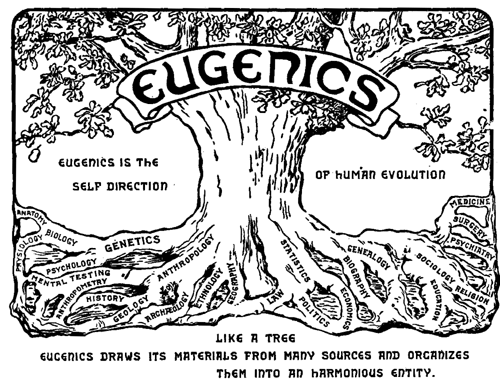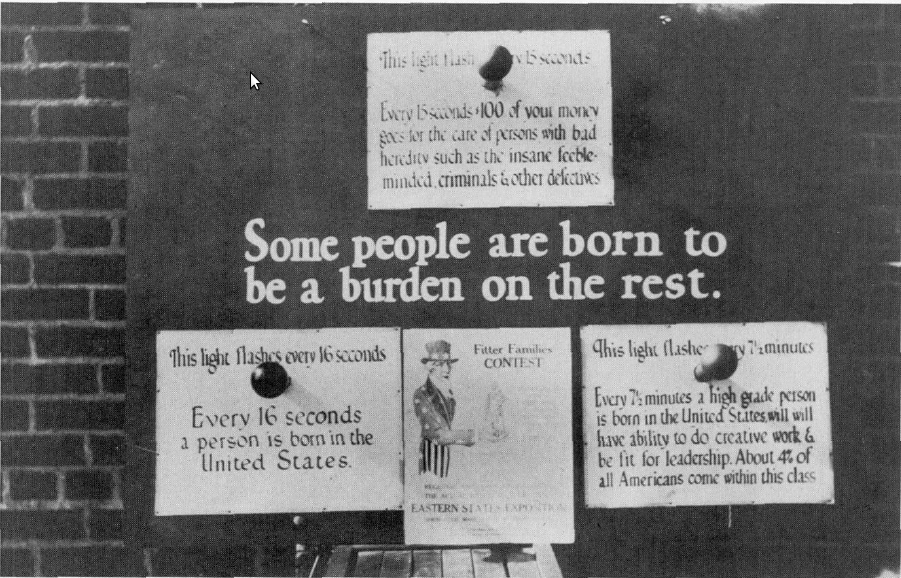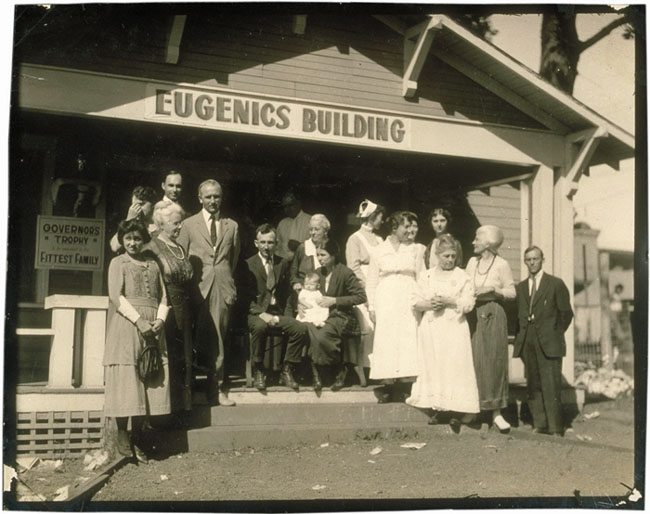Early in the twentieth century, governments all over the world thought they had found a rational, efficient, and scientific solution to the related problems of poverty, crime, and hereditary illness. Scientists hoped they might be able to help societies control the social problems that arose from these phenomena. All over the world, the science-turned-social-policy known as eugenics became a base-line around which social services and welfare legislation were organized.
Philippa Levine, co-editor of a newly published book on the history of eugenics, explains the appeal and wide-reaching effects of the eugenics movement, which at its best inspired access to pre-natal care, access to clean water, and the eradication of harmful diseases, but at its worst led to compulsory sterilization laws, and the horrific experiments of the Nazi death camps.
Guests
 Philippa LevineMary Helen Thompson Centennial Professor in the Humanities, UT-Austin
Philippa LevineMary Helen Thompson Centennial Professor in the Humanities, UT-Austin
Hosts
 Joan NeubergerProfessor of History, University of Texas at Austin
Joan NeubergerProfessor of History, University of Texas at Austin
What was eugenics?
Well eugenics is a funny word, and it sounds, I think, quite funny to the modern ear. But you can kind of break it down as essentially “the science of good breeding.” It comes out of the Greek originally, and it really is about what you pass on to the next generation, what happens to your offspring. Therefore: who the parents are and what qualities parents bring to baby making. So that’s really what eugenics is when it becomes a government policy. But it starts out as a science.
The term is produced by a guy called Francis Galton, who was a British scientist, and traveler, and writer—scientist in the very loosest way. Remember, this is a period in which scientists don’t train in universities. But Galton was very interested in mathematics and particularly statistics. Probability was his thing and he had read Charles Darwin’s work who was a distant cousin of his, and became very excited at the idea of heredity. Because, of course, Darwin’s work is all about heredity. It’s about evolution, but also about what happens with offspring: what do offspring take from their parents?
There are great debates about this in the 19th century. Darwin wasn’t the only voice. So eugenics picks up on this big debate that really gels around the 1850s-1860s. And even before he invents the term “eugenics” in 1883—that’s the first we know of in which the term comes out—Galton is already interested in thinking about what the probability of producing a genius is, in particular. His first interest is in intelligence; it’s not in race, it’s not in class, it’s in intelligence. It’s very interesting.
At the same time, he travels to Africa in the 1850’s, and he’s very interested in what he sees as the bodily racial differences between white people and Africans. So he’s bringing all this stuff together, and he publishes in the early period, but then invents this term in the late 1880s.
But it is part of a bigger movement around evolution, around classification, but also around the changes that are happening politically. Governments are beginning to say, “we have bigger populations, we’ve got population growth, we have social problems that come out of that, we’ve got bigger cities, how do we manage populations?” So a lot of what eugenics becomes about around the early 20th century is literally the management of population.

So how do we get form a biological theory to social policy?
That as a wonderful question Joan. Because that’s really what’s so interesting about eugenics, that on the one hand it is a science—not a very good science, but at the time it was considered good science. And on the other hand, it is a set of social policies. And I think a lot of that has to do with the fact that across the developed world and also across the colonial world—which of course is run by the developed nations—you have in the early 20th century increasing anxiety about this control and management of populations. For lots and lots of reasons: You want to make sure the populations don’t revolt. You want to make sure that populations do the things that you need them to do. You want to make sure you’ve got the labor force that you need.
On the other hand, it’s expensive to manage populations, right? It’s very expensive to have welfare provisions of various kinds. So governments are looking for cheap, efficient ways to control populations. And if you can do something to your problem populations—the people who you’ve got as a problem, the people who end up in prison, the people who end up in the gutter, the people that have unpleasant diseases—If you can stop them from reproducing, the theory is that in the next generation it will be much cheaper to control your population. So the social policy aspect in some ways is about what one historian, writing in the 1970s, called “national efficiency.”
So if we’re talking about inheritance of traits, we’re talking about reproduction so then were talking about sex, how is the discussion of eugenics gendered in public policy?
It is deeply gendered in public policy. It comes back to sex, it comes back to family and, therefore, particularly in the early 20th century/the late 19th century it comes back to women. So an enormous amount of eugenic policy—although it does affect men as well—is aimed at women. If you can stop the wrong women from having babies then you go a long way towards—at least that’s how the theory was—you go a long way towards dealing with your problem. And so there was — for instance in this country, in the United States, sterilization— compulsory involuntary sterilization—was a very very common technique; 27 states in the US by the early 1930s had compulsory sterilization laws on the books.
Who was subject to compulsory sterilization?
That’s also an interesting and complicated question.

The people in power get to decide who the problem is?
That’s the problem. People in power, that is to say: scientists, politicians, welfare workers very often, but the people who get sterilized will differ from state to state. So, for instance in Virginia—which was a very very important state in the sterilization and eugenic debates because it’s the state that led to the Supreme Court decision that really made compulsory sterilization constitutionally legal—in Virginia the most likely recipients of compulsory sterilization techniques were actually poor whites. It was people from the wrong side of the tracks, who “brought down” whiteness, who were the major target. And they ended up mostly at a place called the Lynchburg Colony, which was essentially a mental asylum. And the price of freedom, the price of getting out of there was that your tubes were tied.
If you move across the country to California—which is also a very important state in eugenics because it sterilized more people than any other state in the union—most of the people are either Mexican American or increasingly African American. So it isn’t only about class, or only about race, or only about gender, but it’s always about all of them. It’s poor people, it’s people who have hereditary diseases, but it’s often people of a particular social class or people whose behavior is seen to be as somehow outside the norm, deviant behavior.
Now as I mentioned earlier you work on the British Empire, so were these sterilization policies similar in imperial and national context, or different?
Well, Britain never actually has compulsory sterilization. It’s very interesting if you look at where you see compulsory sterilization. It’s always something that is quite controversial. Now what’s really interesting is that Winston Churchill, the famous Winston Churchill, was really big on the idea of compulsory sterilization and actually spoke about it in Parliament and encouraged Britain to take that road. Britain did not. Britain was a much more moderate country politically, and he was out of step with British sensibilities.
The countries where you see compulsory sterilization, there were quite a few of them. The US and Nazi Germany were the two big ones. The other really interesting and intriguing place where we see compulsory sterilization is in Scandinavia, and that’s interesting because we think of Scandinavia as this really liberal, kind of welfare minded place. It was part of their set of welfare policies. Now, technically it wasn’t compulsory there, but in real terms it was because, again, the price of freedom from an asylum was having your tubes tied.
Obviously this was a negative effect of eugenics, were there any positives in terms of hygiene or public health policies that came out of this discussion?
Very much so, very much so. And it’s very interesting, because again, one of the fun things about editing this book was that we looked at the entire world. And we did that because we saw these amazingly different policies all grounded in the same science and the same policy—
—and coming up at the same time—
—and coming up at the same time, in the late 19th and particularly the early 20th century, but incredibly different ways of dealing with it. And in fact historians tend to divide eugenics into two categories: positive eugenics and negative eugenics. That’s the phraseology that’s often used.

Positive eugenics includes things such as blood tests before marriage, to ensure that when you go into a marriage at least every party knows if there is hereditary disease or if there is sexually transmissible disease, because of course they can have consequences for newborn babies. There are very serious consequences for gonorrhea and syphilis for neonates, as you may know. That’s one example of positive eugenics.
Others were the tendency to provide both prenatal and postnatal care for mothers, so that mothers and babies got the kind of nutrition they need. In some countries we have what was known by the French name puer et culture, which was adopted not just in France, but across Latin America. And that was essentially welfare for mothers and babies, after the baby was born.
In some cases it was the eradication of endemic diseases, because they were seen as obviously affecting populations. So in a country like Iran or Brazil, that was sort of a main thing. Sometimes it was about the rural water supply because people were dying from those. Because it was population management, even though heredity was at its base, it often incorporated these other things. And in places like Hong Kong and India it becomes birth control practice. Because you have places that have very large populations, they want to limit that population so that they have enough to go around.
So what we see is active birth control mechanisms being put into place, not compulsory ones, but just the availability and access to family planning. So these are more positive ways, in which you are not forcing things on people but you are offering different kinds of services.
I think most people probably associate eugenics with the Nazis, and we will get to them in a second. But I was really interested to discover that the political effects of eugenics were really around the new nations and new politics after World War I. Could you talk about that a little bit? What makes it so common in the world for eugenic policies to spread in that period?
I think it really is this combination, on the one hand, of a real sense of optimism about science being good for society—very powerful, and powerful even today. And on the other hand, I think the changes brought about by urbanization and by new nation states with the promise of the democracy, this was in some ways how you could deal with democracy.
So you give people a lot of power but then you need to control them, is that right?
Democracy comes about in some ways, I think, also, because of population change. In a sense you don’t have that argument when you have a relatively small population. But when you have got a large population, the press for political change is much greater. So, when you put together the fact that you have bigger populations in industrializing counties, which also means that you have young people leaving their families and moving into cities on their own, you have different sexual behaviors and you have different political behaviors. So, I think the combination of those things produces in these new nation states that are interested in what kinds of politics they are going to have.
And this is the moment of welfare. This is the time of Progressivist politics in the United States. It’s the moment in which the liberal party in England is beginning to experiment with what is essentially the beginning of the British welfare state, which will lead ultimately to the National Health Service and all of those kinds of things. This is the moment of welfare. This when the League of Nations also is thinking of welfare in a broader sense. So you have all of that going on.
Add to that this optimism of the importance that science brings to the table—that science is going to be able to produce world peace, that science is going to be able to eradicate disease, that science is going to be able to cure hunger. All of those things are really, really, important. And it’s that combination that’s unbelievably potent and incredibly seductive for both new and old governments.
Well let’s turn to the Nazis, then. To what extent was eugenic science connected with anti-Semitism and the mass murder of a whole population?
There is definitely a connection, but what is really important to stress, and stress, and stress, because I think it’s not understood very well, is that eugenics was already there in Germany in the early 20th century. Berlin had been one of the most active scientific places in the world in the world in the early 20th century. The Rockefeller Foundation helped found the Kaiser Wilhelm foundation, which is one of the major racial hygiene and eugenics research institute in the world in the 1910s and 1920s.
So when Hitler comes to power he is able to plug into an existing highly respected science. The other thing to remember, before we get to the Nazis, is that much of the Nazi policy that was promulgated in 1933, after Hitler’s rise to power, was actually forged in and first really shaped in America. Hitler is very, very clear about what he borrows from American eugenics. American eugenics was very well developed at that point, and one of the first laws that Hitler passes when he comes to power in 1933 is a compulsory sterilization law and a ban on interracial marriage. Well, where did he get both of those?

They were based on American models?
Yes, completely and utterly. There was something called the Model Sterilization Law that a man called Harry Laughlin had helped set up in the United States after the Buck vs. Bell Supreme Court case in 1927. And Hitler borrowed that almost to the word for the 1933 Act. And, of course, Virginia, the place where the Buck vs. Bell decision had really been forged, was also a place that had interracial marriage laws in 1924—the so called “one drop rule” that the Racial Integrity Act forbade. So much of what Hitler does comes from American and other models, but particularly U.S. models.
Of course he takes it to an extreme. What horrified people when they went into the camps at the end of the war, and the stories that came out even before then—this is really what the Nuremburg Doctors Trial was about—is that they were using people in the camps for eugenics research. Not just in the camps but outside the camps. And so doctors in the camps, and this was particularly gruesome, they were doing things like harvesting eyeballs or organs of various kinds and sending them off to their friends who were not working in the camps but doing research. So it fuels both civil and military medical research in the camps, with no sense that they are causing pain and suffering.
So this is where eugenics sort of reaches its most extreme form, but it is important to remember that it is something that is already in Germany prior to the war, prior to Hitler’s rise, and it is also very well developed particularly in the United States, and that is where Hitler is getting his initial models.
And then the Nuremberg Trials at the end of the war, you mentioned the Doctors’ Trials, really exposed this to the world and really exposed the negative sides of eugenics, had a role in the pendulum swinging away from eugenics policies?
Yes, the most important thing that came out of the Nuremberg Doctors’ Trial was the question of informed consent—that you couldn’t experiment on people unless they were aware and they understood what you planned to do and agreed to do that. Now, informed consent is a tricky business in many ways, and it is something that people still struggle with today. But it was the Nuremberg Trials that absolutely put that into place, absolutely.
In a sense, what happened to eugenics is the term disappeared, but the practices did not. And the sterilization, most American states kept their sterilization laws on the books until the 1970s and continued to practice sterilization until there was a bit of a fuss about it in 1970s.
One of the things that this book shows is that eugenics was everywhere in one form or another, but was there opposition to it everywhere as well?
Yes, there was, there was always opposition in every country that you look at, there is no question about that. There were intelligent opponents, there were intellectual opponents, particularly religious opponents. The Catholic Church was horrified by eugenics because one of the thing eugenics did was to encourage birth control and encourage also fiddling with reproduction, messing with reproduction, and you do not do that if you are of the Catholic faith. So the Catholic Church was one of the most vocal of the opponents, but there were many.
But what’s interesting again about eugenics and really worth stressing is that you can’t say “it’s Hitler, therefore its socialism,” or “its Hitler, therefore it’s the right wing.” What’s fascinating is that you have supporters and opponents everywhere on the political spectrum, so people were really such weird bedfellows here. You know, on the one hand George Bernard Shaw and Margaret Sanger were eugenicists. I mean, how different, it’s not Hitler! They would have been horrified. On the other hand, you have left wing lawyers and the Catholic Church teaming up against eugenics. It’s very complicated; it doesn’t fit the way that we think about politics, and for me, that’s what makes it so interesting. You can’t pigeonhole it. You can’t classify it.
It’s sort of disappeared as a major movement, but what is the legacy of eugenics? Do we still have practices that derive from the whole movement and the science?
Many people think, and indeed there is a book called Backdoor to Eugenics by a man called Troy Duster, many people believe that we actually have a great deal of eugenic practice going on in many ways. And that has been more and more the case with the sophistication in genetics has emerged in the last 20-ish years: genome mapping, DNA encoding, those kinds of things. Now that we know how DNA works and how genomes work.
Ultrasounds tell you the sex of the baby, and what’s happening in some countries where male children are more favored than female children, is it’s allowing parents to abort female fetuses. That’s one example of I think, a eugenic practice. Sperm banks in which people can flip through and say, “6’3”, blonde hair, IQ of 140, that’s my donor.” That’s a form of eugenics because what you are doing is scientifically breeding well. The definition of eugenics is “the science of good breeding.”
And choosing traits physical that you assume will convey social and intellectual…
And that, by the way, is the bad science. Because, in fact, what eugenics never understood was that there is no simple passing of traits in those ways, so it’s not as simple as it sounds. Just because he is 6’3”, blonde, and an IQ of 140 doesn’t mean the child will get those characteristics. There are recessive as well as dominant genes. We know that now; they didn’t know that then. By the 1930s—and, in fact, this is another answer to your question—another opposition that really begins to develop in the 1930s is the new genetics. What we call the new synthesis that comes out. The biological new synthesis that leads to a more sophisticated genetics, starting in the 1930s, and major geneticists who earlier had been quite interested in eugenics and thought it had some value start to distance themselves and sever their ties from eugenics. People in this country like Thomas Hunt Morgan, in Britain Lionel Penrose, major geneticists start saying that this science isn’t good science; it’s bad science, in that respect.
It’s extremely interesting to see the connection between the things we think of as science and things we think of as social policy, that are based on something other than logical, rational studies.
I think that’s right. We assume that science is always rational, and that science is always logical, always objective. But I think what we see in eugenics in particular, some of its successors, is that humans are involved. And if humans are involved, subjectivity is involved. So we shouldn’t ignore what science tells us, but we need as humans to take control of what choices are made on our behalf.